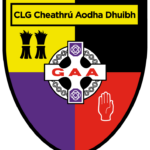CRANN BEATHA
Crann Beatha (👂🏽crann beithe) means the Feeding Tree or Tree of Life and is a Celtic symbol based on an oak tree. It is thought to represent the connections between heaven and earth, between the living and the dead and between the past and the future.

The Crann Beatha sculpture on the CLG Cheathrú Aodha Dhuibh👂🏽 walking track, is fabricated from a 900 mm sculptural steel (Cor-Ten) sphere. The “Tree of Life” pattern is precision laser cut into three main components– the roots, the trunk and the branches, which are interweaved on the front of the globe (👂🏽crúinneog). The roots at the base of the structure appear to descend into the earth and are connected by the trunk of this oak tree to the branches which rise celestially. From a distance, the entire structure appears surrounded by a connecting circle which reinforces the imagery of connections between life, death and the afterlife. The oak tree was a symbol of nobility and endurance amongst the Celts because of its towering strength and longevity. The Irish word for Oak (👂🏽dair) may underlie the origin of the English word door, consistent with the idea that native Irish trees were perceived as doorways to other worlds.
Trees (👂🏽crann) were important symbols in many cultures including ancient Egypt and ancient Greece (An Ghréig), as exemplified by the mythology surrounding the golden apples of the Garden of the Hesperides. Many different religions (👂🏽reiligiún ), including Islam, Judaism and Hinduism also use trees in their teachings and many Christians will be familiar with the trees in the Garden of Eden. Similarly, the Boddhi tree, under which Buddha attained enlightenment, is another important symbol in Buddhism.
However, trees represented much more than cultural significance to the Celts. They symbolised the well-being of the various clans since their life was intimately linked to them. Unlike now, the vast majority (>80%) of Celtic Ireland was under forest and this provided an abundant source of shelter, food, fire fuel, weaponry and medicine. Our native Irish trees were not just essential to Celtic life but were highly venerated, as evidenced by the fact that damage to them was punishable under Brehon Law. For example, if a noble tree (oak, hazel, holly, yew, ash, Scot’s pine or wild apple) was cut down, the perpetrator was heavily fined resulting in the loss of 2 milk cows and a 3-year-old heifer. Although these laws were established more than 2000 years ago, the English replaced them with their own ~400 years ago. Prior to this, Ireland was ruled via a series of relatively independent kingdoms, laws were passed down orally by the Brehons (👂🏽breitheamh) via the judges. These judges (👂🏽ollamh) were wise individuals who not just memorised, but applied our laws to settle disputes amongst clan members. Every three years they would meet on the Hill of Tara during Samhain, one of our four main pagan (👂🏽págánach) feasts and help resolve issues between and within kingdoms.
Over the next 12 months Carryduff GAC will ignite this sculpture to signify the beginning of the ancient festivals of Samhain (October), Imbolc (February), Bealtaine (May), and Lughnasadh (August) and will place QR codes explaining the origin of each festival around the walkway.

Notes:
This sculpture (👂🏽dealbhóireacht) was funded in full by an Ultach Fund grant to Carryduff GAC. The purpose of the grant is to enhance the awareness and use of the Irish Language. It forms the centre-piece of project with local schools to explore the origins and meanings of the four Celtic festivals of Imbolc, Bealtaine, Lughnasa and Samhain which will be completed during 2024.


































